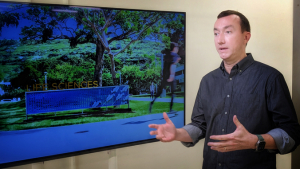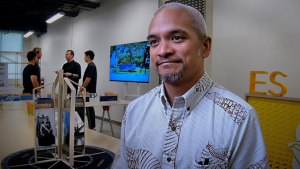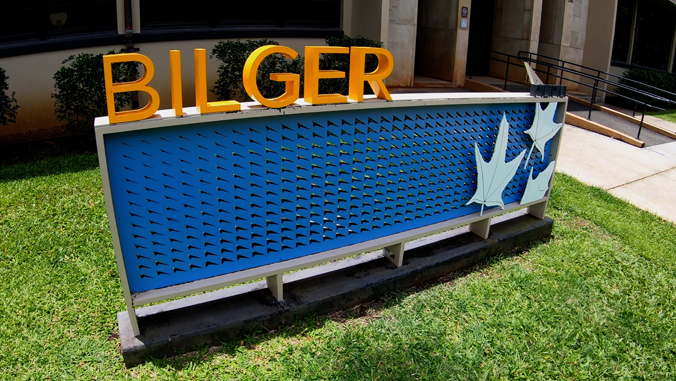
New bilingual signage on the University of Hawaiʻi at Mānoa campus based on kānaka ʻōiwi (Native Hawaiian) knowledge and values received a 2023 World Changing Ideas Award in the Art and Design category on May 2. Fast Company’s World-Changing Ideas Awards honor the innovative ways businesses and organizations are making the world more accessible, equitable, and sustainable for everyone.
“Receiving this award is a huge honor, primarily because it is highlighting the Indigenous knowledge systems that exist in Mānoa valley,” said Brian Strawn, principal investigator at the UH Community Design Center (UHCDC) at UH Mānoa’s School of Architecture. “Highlighting the ecological and cultural significance of this place is of great importance to the university.”
Strawn, along with his co-investigator Karla Sierralta, led the UHCDC team that included staff, student research assistants and graduate students. The UH-based team co-designed the new wayfinding system together with Nalani Kanakaʻole, Sig Zane, and Kūhaʻo Zane of Sig Zane Designs.
There are currently two signs in place in front of the Isabella Aiona Abbott Life Sciences Building and Bilger Hall. Ultimately, signs featuring the new design will be placed in front of a total of 21 of the campus’ main buildings in a multi-phase project expected to be completed by 2030.

The signs invite viewers to take part in kānaka ʻōiwi body alignment practices like those that traditionally occur at some heiau (temples). Each sign will gesture toward different landmarks in and around Mānoa, such as the Waʻahila Ridge or Lēʻahi (Diamond Head) on the coast. The project aligns with UH Mānoa’s commitment to being a Native Hawaiian Place of Learning (PDF) that includes evoking the importance of place among haumāna (students), staff, faculty and the community.
There will be a medallion at each sign with a QR code that will link to an interactive website with information about the specific location.

“With this signage you’ll be able to not only find your way around campus but also be educated about what are the important Indigenous places within this area, or within this ahupuaʻa of Mānoa,” said Kūhaʻo Zane at Sig Zane Designs, who co-designed the signage.
ʻIli ʻāina, subdivisions
Kānaka ʻōiwi divided the islands into ahupuaʻa (land division usually extending from the mountains to the sea) that were made up of subdivisions called ʻili ʻāina, each with its own name and purpose.
Related story: New Mānoa signage features ancient place names, cultural knowledge, July 2022According to an 1882 historical map of Mānoa, multiple ʻili ʻāina intersect on the Mānoa campus. The new signs will feature the building’s name and the name of the ʻili ʻāina the building is located in. There will also be markers installed in different locations on campus that will indicate where ʻili intersect.
“This project is a great example of collaborative authorship,” said Sierralta, associate professor in the School of Architecture. “It is inspiring to see the work of students and design-research teams at UH working in collaboration with talented individuals from our community to acknowledge and celebrate the layered complexity of place.”
The project is a joint venture of the UHCDC, Office of the Vice President of Administration, Sig Zane, Nālani Kanakaʻole, Kūhaʻo Zane (Sig Zane Designs), Daniel Friedman (Design Advisor), Kaiwipunikauikawēkiu Punihei Lipe (UH Mānoa Native Hawaiian Affairs Program Officer), Wayfinding Consultants (Two Twelve), Global Specialty (Contractors) and CREO Industrial Arts (Fabricators).


